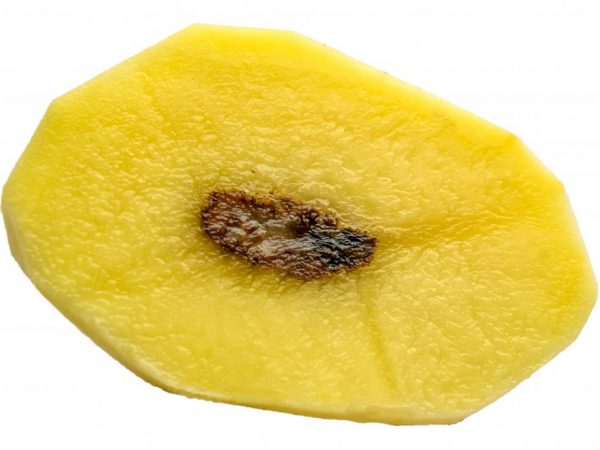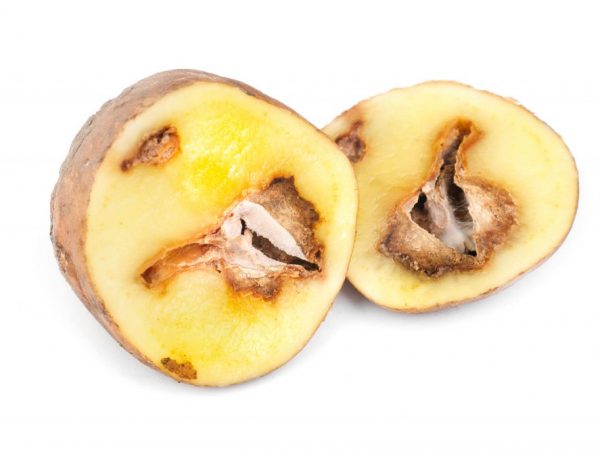Why did the potatoes turn black inside
The blackened potato inside is not a normal external pitchfork of the culture, normally it should not be. Most often, such spots appear due to the fact that mistakes were made during cultivation, as well as during storage of potatoes, however, it also happens that gray spot is a consequence of the development of a particular disease. Let's figure out in more detail why the potatoes turn black and how to deal with this condition.

Causes of blackness inside potatoes
Blackened when grown
Why potatoes can turn black inside during the growing phase:
- Too much nitrogen in the soil, or potassium deficiency. Undiluted organic matter added to the ground can also cause darkening of the pulp, potatoes do not like the introduction of concentrated products;
- During cultivation, watering errors were made, it can be both overflowing and underwatering;
- The crop was harvested either too early, or, conversely, too late. In the first case, the tubers simply do not have time to ripen, in the second, they are too long in the warm earth and die.
Storage blackening
Quite often, potatoes turn black inside during storage, we will find out why this happens:
- Potatoes become covered with dark spots when they are in a warm place for a long time or in a room with insufficient ventilation. Usually, the first manifestations appear after 1-2 months of improper storage;
- The normal storage temperature for potatoes is considered to be the range from 2 to 4 degrees with a plus mark, if the temperature is lower, the vegetable freezes, if higher, then dark spots may appear.
In addition, it should be said that the blackening of the pulp can occur due to the fact that you have planted a variety in which too much starch is present. The fact is that it is these varieties that suffer from this problem, most often it manifests itself during the cooking of the vegetable.
Blackening due to cultural diseases
As mentioned earlier, this or that disease can become the cause of the appearance of dark spots, we will find out why the potatoes can turn black inside, what diseases contribute to this:
Blackleg
It is an infectious disease that is transmitted from an infected tuber to a healthy one. Moreover, the further spread of the disease can occur already in bags, when the potato crop has already been harvested and the fields are empty. Outwardly, this condition can be distinguished from gray spot, because from the inside the tuber will turn black already from the stalon. Black spots first cover the middle of the potato, later move to the vascular branches, appearing on the peel. Also, a distinctive characteristic of the disease is a characteristic unpleasant putrid odor. It is important to spot the problem early in the growing phase to prevent the spread of the disease.
Melanosis
Next, we will focus on a disease such as melanosis. Externally, the tuber and skin of the affected crop will look normal, unchanged, but at this point, blackness continues to increase under the skin.It is worth saying that the affected vegetables remain suitable for food, which cannot be said about the previous disease - black leg. In order for the stains not to increase in size and the cooked dish to look more or less attractive and appetizing, you need to add vinegar and citric acid to the water during cooking, while peeling the peel is not necessary.
The reasons for the appearance of melanotic spots can be different, for example, mechanical damage to a vegetable.
Most often, potato varieties with a high starch content in the pulp suffer from melanosis; it becomes dark more often than others. In addition, the development of the disease is accompanied by errors in the choice of the harvest time. It is worthwhile to correctly treat this aspect, as well as to do everything so as not to injure the tubers during the harvest.

High humidity can be the cause of the disease.
Placing beets in bags of potatoes is an excellent prevention of melanosis, which helps to keep the potato pulp intact. The fact is that the beet will help to overcome the problem of excessive moisture in the place where the tubers are stored.
Late blight
Another reason for the appearance of such spots on the pulp may be late blight. This disease takes place in any region, including the entire territory of Russia. A distinctive feature of the disease is that not only the tuber is affected, but the leaves of the plant. This fact greatly complicates the fight against the pest. If preventive measures are not taken in time, there is a possibility that the fungus can infect all plants and crops growing in the garden or field.
Signs of late blight
- Leaves develop brownish spots and dots
- Leaves rot and then shrink
- The final stage is their fall
Causes of late blight
Infection with late blight occurs as follows and for the following reasons:
- Remnants of weeds and other vegetation were removed at the wrong time
- The seedlings were initially infected with a fungus
- Errors were made in the technology of growing potatoes.
It is worth saying that the scale of late blight is impressive, the disease spreads very quickly. The peak incidence occurs during the flowering period of the bush, although in most cases the infection period can shift in one direction or another depending on weather conditions. The most favorable time for the reproduction and spread of the fungus is wet and damp weather - rainy autumn or thaw in spring. In addition, excessive watering of potato bushes will contribute to the spread of infection, thus, pathogenic microflora will move along with moisture through the soil. It is worth saying that, despite the fact that late blight in itself is a danger to the future harvest, the disease also significantly increases the chances of infection with other ailments, for example, various fungal diseases or wet rot.
Prevention of late blight
In order to preserve and protect your crop from being affected by late blight, you need to know all the preventive measures, because they are quite simple, as opposed to getting rid of the disease, which involves getting rid of infected bushes. We will try to list the main preventive measures that every farmer should know:
- Do not cover the harvested potatoes with tops. If there are infected leaves, there is a risk that the disease will soon spread to the tubers.
- Harvest according to the variety of potatoes. So, earlier varieties should be dug out earlier, without waiting for the density of the peel, while later ones - later.
- Observe the watering rates, do not forget to add fertilizers to the soil on time.
Control methods
What to do if, despite all preventive measures and sufficient care, the tops of the potatoes still turn black? In this case, you need to throw all your efforts to overcome the disease as quickly as possible, until the problem becomes more global in nature.If you find a slight blackening of the leaves on a potato bush, take the following measures:
- Spray potato leaves with Bordeaux mixture or copper oxide with chlorine, usually a seven-day treatment is enough to fix blackening problems once and for all. In this case, each sheet is processed, and this must be done from both sides
- If you find a disease at an advanced stage, that is, the potato bush has turned pretty black, there is not a single green leaf left on it, there is no point in saving it
- After all the above actions have been carried out, it is necessary to mow and then destroy all the tops that were affected by the disease, and they do this strictly 7 days before harvesting.
- After the crop is harvested, it is important to ensure normal storage conditions for the crop, that is, comply with the requirements for ventilation, temperature and lighting. It is important to re-check the crop after 2-3 weeks of storage in order to exclude black tubers.
Now you know why potatoes turn black on the inside during storage. In conclusion, let's say that blackening of potatoes is quite common, it is enough to comply with all the requirements for growing and storing crops, choosing potato varieties with a normal starch content, thereby reducing the risk of a problem to a minimum.


